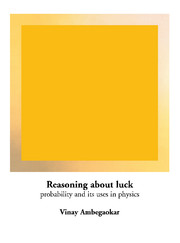Book contents
- Frontmatter
- Contents
- Preface
- 1 Introduction
- 2 The likely, the unlikely, and the incomprehensible
- 3 Normality and large numbers
- 4 Examples
- 5 A little mathematics
- 6 Forces, motion, and energy
- 7 Atoms, molecules, and molecular motion
- 8 Disorder, entropy, energy, and temperature
- 9 Heat, work, and putting heat to work
- 10 Fluctuations and the arrow of time
- 11 Chaos
- 12 Quantum jumps: the ultimate gamble
- Index
6 - Forces, motion, and energy
- Frontmatter
- Contents
- Preface
- 1 Introduction
- 2 The likely, the unlikely, and the incomprehensible
- 3 Normality and large numbers
- 4 Examples
- 5 A little mathematics
- 6 Forces, motion, and energy
- 7 Atoms, molecules, and molecular motion
- 8 Disorder, entropy, energy, and temperature
- 9 Heat, work, and putting heat to work
- 10 Fluctuations and the arrow of time
- 11 Chaos
- 12 Quantum jumps: the ultimate gamble
- Index
Summary
… the whole burden of philosophy seems to consist in this – from the phenomena of motions to investigate the forces of nature, and then from these forces to demonstrate the other phenomena …
Isaac NewtonProbability enters theoretical physics in two important ways: in the theory of heat, which is a manifestation of the irregular motions of the microscopic constituents of matter; and, in quantum mechanics, where it plays the bizarre but, as far as we know, fundamental role already briefly mentioned in the discussion of radioactive decay.
Before we can understand heat, we have to understand motion. What makes objects move, and how do they move? Isaac Newton, in the course of explaining the motion of planets and of things around us that we can see and feel with our unaided senses, answered these questions for such motions three centuries ago. The science he founded has come to be called classical or Newtonian mechanics, to distinguish it from quantum mechanics, the theory of motion in the atomic and sub-atomic world.
Classical mechanics is summarized in Newton's ‘laws’ of motion. These will here be illustrated by an example involving the gravitational attraction, described by Newton's ‘law’ of gravitation.
- Type
- Chapter
- Information
- Reasoning about LuckProbability and its Uses in Physics, pp. 80 - 101Publisher: Cambridge University PressPrint publication year: 1996

